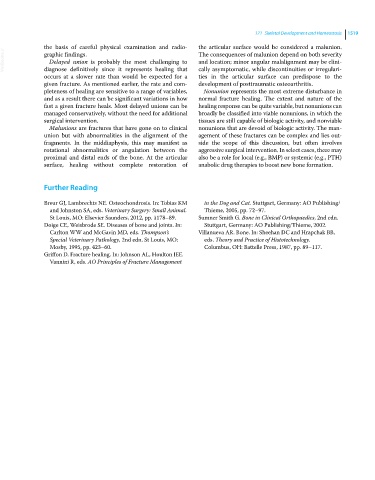Page 1581 - Clinical Small Animal Internal Medicine
P. 1581
171 Skeletal Development and Homeostasis 1519
the basis of careful physical examination and radio- the articular surface would be considered a malunion.
VetBooks.ir graphic findings. The consequences of malunion depend on both severity
Delayed union is probably the most challenging to
and location; minor angular malalignment may be clini-
diagnose definitively since it represents healing that
ties in the articular surface can predispose to the
occurs at a slower rate than would be expected for a cally asymptomatic, while discontinuities or irregulari-
given fracture. As mentioned earlier, the rate and com- development of posttraumatic osteoarthritis.
pleteness of healing are sensitive to a range of variables, Nonunion represents the most extreme disturbance in
and as a result there can be significant variations in how normal fracture healing. The extent and nature of the
fast a given fracture heals. Most delayed unions can be healing response can be quite variable, but nonunions can
managed conservatively, without the need for additional broadly be classified into viable nonunions, in which the
surgical intervention. tissues are still capable of biologic activity, and nonviable
Malunions are fractures that have gone on to clinical nonunions that are devoid of biologic activity. The man-
union but with abnormalities in the alignment of the agement of these fractures can be complex and lies out-
fragments. In the middiaphysis, this may manifest as side the scope of this discussion, but often involves
rotational abnormalities or angulation between the aggressive surgical intervention. In select cases, there may
proximal and distal ends of the bone. At the articular also be a role for local (e.g., BMP) or systemic (e.g., PTH)
surface, healing without complete restoration of anabolic drug therapies to boost new bone formation.
Further Reading
Breur GJ, Lambrechts NE. Osteochondrosis. In: Tobias KM in the Dog and Cat. Stuttgart, Germany: AO Publishing/
and Johnston SA, eds. Veterinary Surgery: Small Animal. Thieme, 2005, pp. 72–97.
St Louis, MO: Elsevier Saunders, 2012, pp. 1178–89. Sumner Smith G. Bone in Clinical Orthopaedics, 2nd edn.
Doige CE, Weisbrode SE. Diseases of bone and joints. In: Stuttgart, Germany: AO Publishing/Thieme, 2002.
Carlton WW and McGavin MD, eds. Thompson’s Villanueva AR. Bone. In: Sheehan DC and Hrapchak BB,
Special Veterinary Pathology, 2nd edn. St Louis, MO: eds. Theory and Practice of Histotechnology.
Mosby, 1995, pp. 423–60. Columbus, OH: Battelle Press, 1987, pp. 89–117.
Griffon D. Fracture healing. In: Johnson AL, Houlton JEF,
Vannini R, eds. AO Principles of Fracture Management

